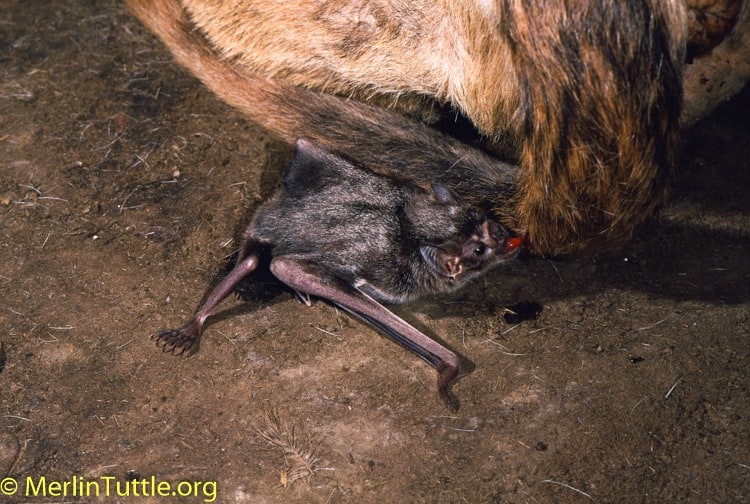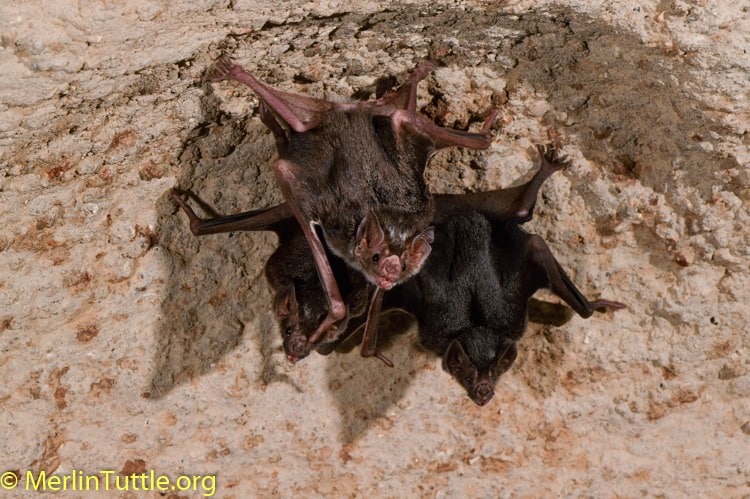Tracking the Impacts of WNS at Wisconsin’s Stonefield Historic Site
“Just like the old days, eh Heather?” Kent softly clicks his tally counter as he sits in his folding chair on the other side of
Bats are currently facing the most harmful media campaign seen in more than 30 years. The latest outrage is an article titled “Bat attacks on humans increasing due to urbanization and deforestation,” published in the British online newspaper, The Independent, on June 3, 2017.
Once again, bats are plagued with a rash of sensational bat-attack and bat-disease stories, promoted by clever, but unscrupulous persons who know better. The motivation remains the same—greedy competition for public health funding. As noted by Mexico’s leading bat biologist and conservationist, Dr. Rodrigo Medellin, “unsupported statements and partial truths have been cleverly interwoven to present a picture that bats are the most dangerous, filthy, pathogen-harboring organisms on earth.” So-called virus hunters are linking already feared bats with deadly, but rare diseases, misleading governments to invest billions of dollars in projects of questionable value in saving human lives (USCDC 2015).
The current article in The Independent, is typical, first the scary headline that leaves a lasting impression on readers, despite later qualifiers, most of which go unread. The subtitle says, “Diseases in bats have been around for a long time and historically have not been a problem. Now, there is cause for concern.”
Those promoting this international campaign of fear are clever wordsmithers. They know just enough about bats and diseases to almost imperceptibly distort the truth, scaring people about potential, but unlikely events. Extremely low risks are made to seem imminent and possibly disastrous. And since neither bats nor viruses are well understood, they are ideal victims for such manipulation.

The article claims bats have been attacking humans in increasing numbers because their natural habitats are being destroyed through deforestation. This is a commonly propagated myth in recent scare stories. It appears to be an attempt to look like the writer isn’t anti-bat, but is simply attempting to be helpful. Bats nearly everywhere are in decline, and a growing proportion of the human population now lives in cities where there is less, rather than more likelihood of contact with bats. A veterinary college professor is quoted as saying that expanding cities are causing increasing contact—just the opposite of reality. The professor sounds like a reliable source, though he likely has no personal experience with bats.
It is reported that more than 40 people were bitten by vampires in just three months, with one death from rabies. But that’s in all of northeastern Brazil. This is likely one of the rarest causes of mortality that could have been reported for such a large area. Far more deaths likely occurred from bicycle accidents or dog attacks, though no one is likely to advocate ridding the area of bicycles or dogs!
The story verifies our worst concerns, reporting that authorities are “trying to control the bats, poisoning them and removing their roosting sites.” Highly beneficial species form the largest, most conspicuous colonies so they are the ones most easily found, becoming innocent victims of mass killing. In the current article, a doctor stresses that “Brazilian authorities must take the threat seriously.” And an accompanying photo shows an insect-eating bat, looking exceptionally vicious because it is snarling in self-defense.
Not until the next to last paragraph is it admitted that “Bats in the UK do not pose a threat to the human population.” This nearly universally repeated approach gives authors a disclaimer, but it appears deliberately located where it is least likely to be noticed.

Choose any or all means of contact to reach out and share your opinion in your own words.
Send a Contact Form to The Independent. Be sure to include the article and author information.
Leave a comment on the article page
Bibliography
Annonymous. 2017. FY 2015-2019 Ebola response funding. U.S. Centers for Disease Control and Prevention.
Love our content? Support us by sharing it!
“Just like the old days, eh Heather?” Kent softly clicks his tally counter as he sits in his folding chair on the other side of
An important new study, recently published in Science and widely covered by major newspapers like The Guardian, The Washington Post, and The New York Times, has
On March 6, 2024, the Wall Street Journal presented findings from the University of Leeds in their opinion piece, “Why Scientists Love Chasing Bats; The
Response to Misleading Scientific American Bat Story I am responding to the article titled, “A Secret Weapon in Preventing the Next Pandemic: Fruit Bats,” which
2024 © Merlin Tuttle’s Bat Conservation. All rights reserved.
Madelline Mathis has a degree in environmental studies from Rollins College and a passion for wildlife conservation. She is an outstanding nature photographer who has worked extensively with Merlin and other MTBC staff studying and photographing bats in Mozambique, Cuba, Costa Rica, and Texas. Following college graduation, she was employed as an environmental specialist for the Florida Department of Environmental Protection. She subsequently founded the Florida chapter of the International DarkSky Association and currently serves on the board of DarkSky Texas. She also serves on the board of Houston Wilderness and was appointed to the Austin Water Resource Community Planning Task Force.
Michael Lazari Karapetian has over twenty years of investment management experience. He has a degree in business management, is a certified NBA agent, and gained early experience as a money manager for the Bank of America where he established model portfolios for high-net-worth clients. In 2003 he founded Lazari Capital Management, Inc. and Lazari Asset Management, Inc. He is President and CIO of both and manages over a half a billion in assets. In his personal time he champions philanthropic causes. He serves on the board of Moravian College and has a strong affinity for wildlife, both funding and volunteering on behalf of endangered species.